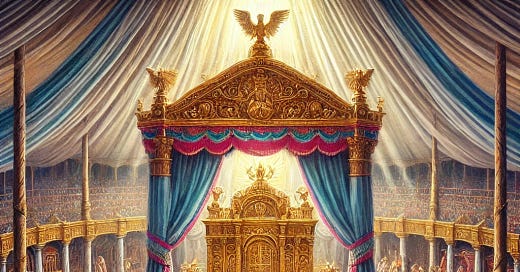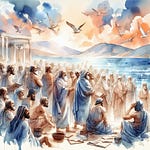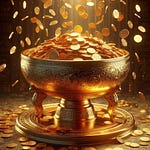Chapter 29: Consecration of the Priests
God instructed Moses on how to consecrate Aaron and his sons for the priesthood. The ceremony involved sacred garments, anointing oil, and three sacrificial animals—a bull for sin, a ram for a burnt offering, and another ram for ordination.
The blood of the ram was placed on the right earlobe, thumb, and big toe of each priest, signifying their hearing, actions, and walk before God. Bread and cakes from the basket of consecration were waved before the Lord.
For seven days, the priests were to remain at the entrance of the Tabernacle, and each day, sacrifices were offered. This sacred rite was about transformation—setting them apart to serve in God’s holy presence.
Chapter 30: The Altar of Incense and Offerings
God commanded the creation of a golden altar for burning incense, to be placed before the veil in the Tabernacle. Every morning and evening, Aaron was to burn incense upon it—a symbol of continual prayer rising to God.
Instructions also included an annual atonement tax—a half shekel from every man, rich or poor—given to the sanctuary.
God ordered the making of a bronze basin for washing, ensuring the priests remained clean as they approached His presence. Special formulas were given for holy anointing oil and sacred incense, not to be replicated for personal use.
These details emphasized God's holiness and the importance of reverent worship.
Chapter 31: Artisans and the Sabbath
God chose Bezalel, filled with His Spirit, wisdom, and skill, to lead the craftsmanship of the Tabernacle. Alongside him, Oholiab was appointed as his assistant. Together, they were tasked with creating all the sacred items God had commanded.
But amid all this creative activity, God reminded Moses of the Sabbath. It was to be a sign of the covenant, a day of rest, holy to the Lord.
Then, God gave Moses the two stone tablets of the covenant law, written by His own finger. The stage was set for communion—but also confrontation.
Chapter 32: The Golden Calf
While Moses was on the mountain, the people grew restless. They asked Aaron to make them a god. Aaron fashioned a golden calf from their earrings, and the people celebrated with feasting and revelry.
God was enraged. He threatened to destroy them, but Moses interceded, pleading for mercy. God relented.
Descending the mountain, Moses smashed the tablets when he saw the idolatry. He burned the calf, ground it to powder, scattered it on water, and made the people drink it.
Three thousand died that day as the Levites executed judgment. Moses returned to the Lord to plead again, even offering his own life as atonement.
Sin had shattered their communion—but grace, through Moses’ intercession, kept hope alive.
Chapter 33: The Tent of Meeting and God’s Presence
God told Moses to lead the people toward the Promised Land but said He would not go with them, lest He consume them in His holiness. The people mourned.
Outside the camp, Moses set up the Tent of Meeting. There, he spoke with God face to face, like a friend. Moses pleaded again: 'If Your Presence does not go with us, do not send us up from here.
God agreed and promised, 'My Presence will go with you, and I will give you rest.
Moses then asked to see God's glory. God would show His goodness, but His face could not be seen—only His back as He passed by.
Chapter 34: New Tablets and a Renewed Covenant
God called Moses to chisel out two new tablets and ascend Mount Sinai again. There, God proclaimed His name—'The Lord, the Lord, compassionate and gracious… abounding in love and faithfulness.
God renewed His covenant, warning Israel not to make treaties with idol-worshiping nations. They were to destroy pagan altars and remain separate.
He repeated commands for festivals, firstfruits, and the Sabbath. Moses remained with God for forty days and nights, without food or water.
When he descended, his face radiated light—so much so that he had to wear a veil. The people saw the glory of God reflected through their mediator.
Exodus 35: The Call to Give and the Sabbath Rest
Moses assembled the whole community of Israel and reminded them that the Sabbath was to be a day of rest, holy to the Lord. No fire was to be kindled on that day. Then he called for offerings to be brought—gold, silver, bronze, fine linens, goat hair, ram skins dyed red, acacia wood, oils, spices, and precious stones—to build the Tabernacle.
Men and women whose hearts were stirred and willing brought their contributions. Skilled artisans among them, particularly Bezalel and Oholiab, were appointed to oversee the work, for they were filled with the Spirit of God, given wisdom, understanding, and ability to craft all that God had commanded.
Exodus 36: Construction Begins and Offerings Overflow
Bezalel and Oholiab, along with all skilled workers, began constructing the sanctuary. The people continued bringing more than enough offerings each morning. Eventually, Moses had to order them to stop giving because they had more than needed.
The workers made the ten curtains of fine twisted linen with cherubim skillfully embroidered, along with the loops and clasps that joined them.
They constructed the boards of acacia wood, sockets of silver, bars, and supports to form the Tabernacle’s framework. They also made the veil to separate the Holy Place from the Most Holy Place.
Exodus 37: Crafting the Holy Things
Bezalel made the Ark of the Covenant using acacia wood and overlaid it with pure gold inside and out. He crafted the mercy seat with two cherubim facing each other.
He made the table for the bread of the Presence, decorated with gold rings and carrying poles. He also fashioned the golden lampstand with branches, cups, buds, and flowers, all of one piece, hammered from pure gold.
The altar of incense was made from acacia wood and overlaid with gold, used for burning sweet incense in the presence of the Lord.
Exodus 38: The Bronze Altar and Courtyard
The craftsmen built the altar of burnt offering from acacia wood overlaid with bronze. It had horns on its four corners, grates, and carrying poles.
They made a bronze basin and stand from the mirrors of the women who served at the entrance to the Tabernacle. The courtyard was enclosed with linen curtains, pillars, bronze sockets, and silver hooks.
A detailed inventory was kept of the materials: 29 talents and 730 shekels of gold, 100 talents and 1,775 shekels of silver, and 70 talents and 2,400 shekels of bronze were collected and used.
Exodus 39: Garments for Glory and Beauty
The workers made sacred garments for Aaron and his sons, as the Lord had commanded.
The ephod was crafted from gold, blue, purple, and scarlet yarn with fine linen.
The breastpiece held twelve precious stones representing the twelve tribes of Israel.
They made robes, tunics, turbans, and sashes, all skillfully woven.
A gold plate inscribed with 'Holy to the Lord' was attached to the high priest’s turban.
When everything was finished, they brought the items to Moses. He inspected all the work and found it had been done just as the Lord commanded. Moses blessed them.
Exodus 40: The Tabernacle Completed and God’s Glory Fills It
The Lord instructed Moses to set up the Tabernacle on the first day of the first month.
Moses assembled the structure, placed the Ark in the Most Holy Place, set up the table, lampstand, and altar of incense, and hung the veil. He anointed and consecrated the Tabernacle and all its furnishings.
Aaron and his sons were brought forward, washed, clothed in their priestly garments, and anointed for service. When Moses completed the work, the cloud of the Lord covered the Tent of Meeting.
The glory of the Lord filled the Tabernacle so fully that Moses could not enter. From that day forward, the cloud guided Israel—when it lifted, they traveled; when it stayed, they remained camped.
The presence of the Lord was visibly with them in a cloud by day and fire by night.












Share this post